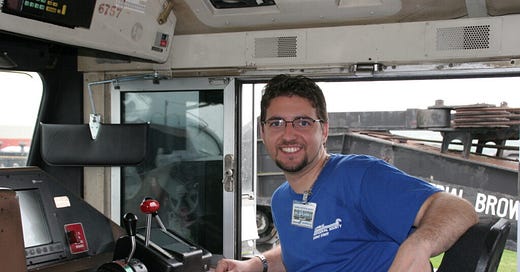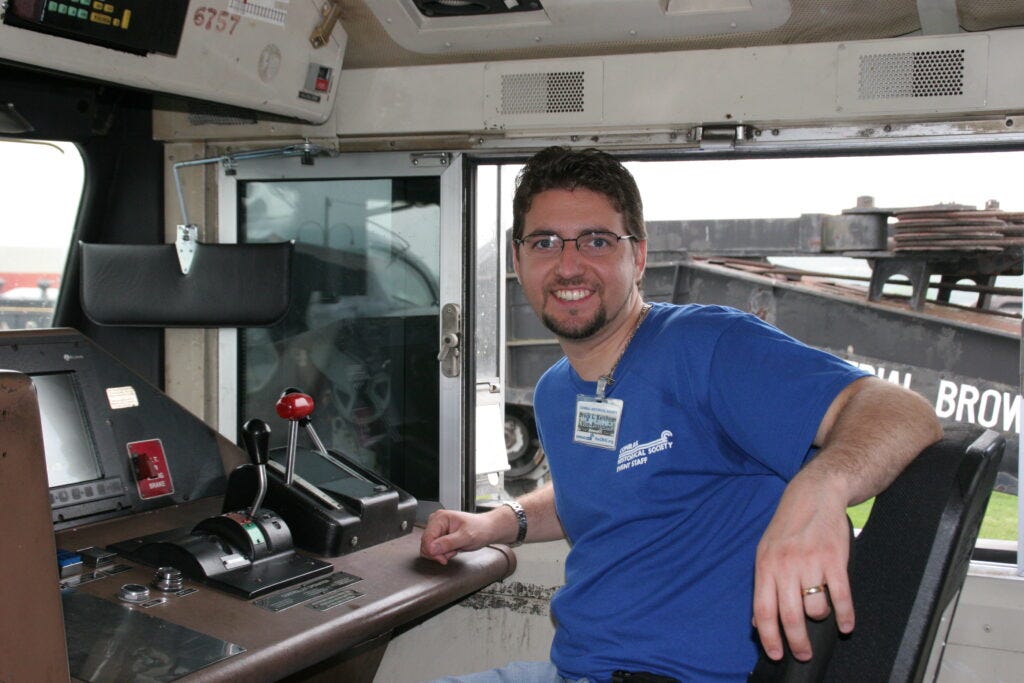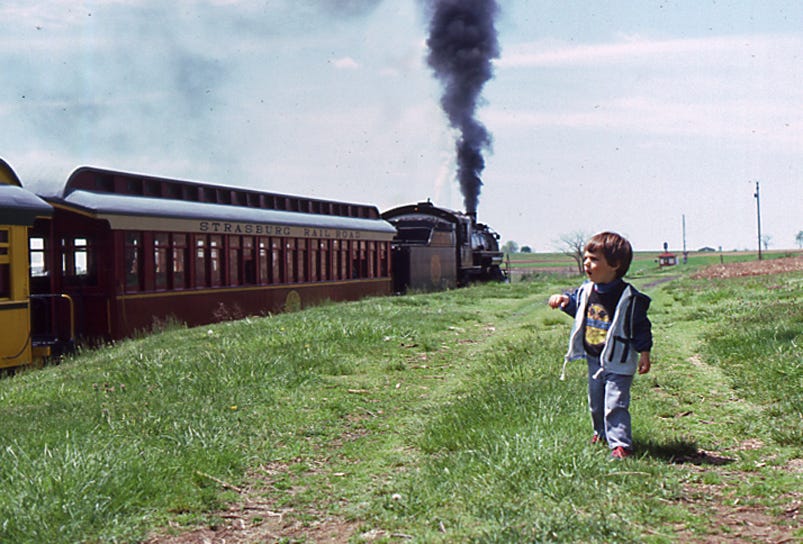“Those [railroaders] need their stories told”
In 2009, Brock is giving cab tours of a former Conrail SD60I locomotive at the Railroad Museum of Pennsylvania, in Strasburg, PA. Photo by Kris Klemick.
This week’s narrative called upon a memory from a time when I started to lose interest in trains when I was younger. No matter what, however, I always found myself coming back to the tracks, waiting to see another train snake its way through my neighborhood. No matter – I could never kick my likeness towards trains. Today we’ll chat with Brock Kerchner, who compared his passion for railroading to the chemical that exists in the bloodstream of Jedi Knights from the famous Star Wars films. From Behind the Throttle comes Brock Kerchner: Persistence and Passion.
Brock Kerchner was born into a family that lacked any sort of railroad connection. However, his love for trains took off when he first visited the nearby Strasburg Rail Road in 1981, when Brock was only two years old. This brief visit to the railroad “…woke up whatever it is that lives in my blood that makes me love trains,” as Brock said it himself. He told me that his parents found him making train sounds in his crib the next morning, a telltale sign that visits to Strasburg were soon to become a frequent family outing. As Brock grew older, visits to Strasburg remained constant and helped fuel his newfound love. The colorful passenger cars and the infamous “egg” logo that the passenger cars sported were a trademark of his childhood. Even as Brock began high school, he still found time for trains among the other things happening in his life.
A family photo from Brock’s childhood at the Strasburg Rail Road. Engine 90 and the passenger cars are sporting the retro “Egg” logo, as the train charges through past the Cherry Hill crossing shanty.
Once Brock graduated high school and began studying at Lebanon Valley College, a new passion for photography became pertinent in his life. The Conrail mainline that ran straight through the college campus provided him with a great opportunity to combine his two passions. Along with his studies, Brock always made time to document the ever-changing landscape of freight railroad that unfolding right before his eyes. Through his dorm-room window, Brock saw the fall of Conrail as Norfolk Southern gained control of the former Pennsylvania mainline. In 2005, Brock immediately jumped on board with the Conrail Historical Society (CRHS), a recently re-organized preservation group. Brock moved up the totem pole quickly, going from a board member to filling the role of vice president or director for almost a decade. During his tenure, Brock and the CRHS helped create the first “Ride the Rails for Cancer,” an event that has raised thousands of dollars for Cancer families in the past couple years. Working with the CRHS, Brock made several contacts with former Conrail employees and shortlines, and was grateful for the journey that the CRHS took him on. However, as Brock’s full time-job with iHeartMedia became more time consuming, he stepped down from his position, with hopes of returning in the future.
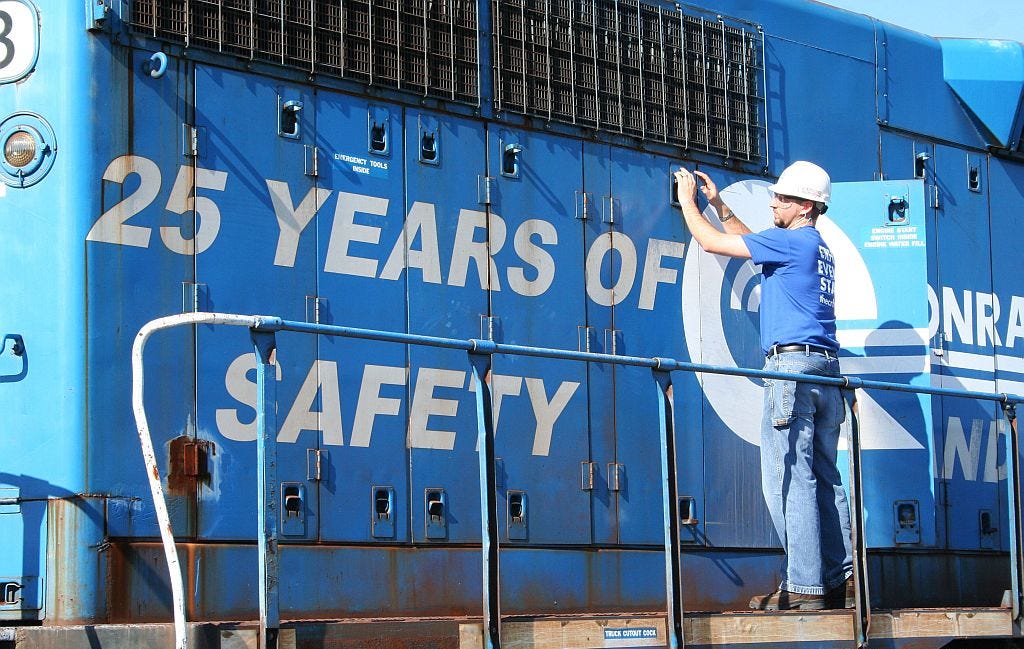
Brock cleaning up NS 2943, “The Spirit of Conrail”, during the CRHS Altoona Convention. Photo by Kris Klemick
Though Brock left his position at the CRHS, trains found a way to meddle themselves back into his life. In 2009, Twentieth Century Fox contacted Brock’s employer asking for radio station stickers for an upcoming movie. When prompted by one of Brock’s coworkers, the film crew told her that this movie was about a runaway train. A lightbulb clicked in this coworker’s head, as she immediately gave them Brock’s contact information for a consulting position for the film. After an initial phone call, the film crew purchased several of Brock’s photos for use as decoration pieces in the various offices used in the film. Additionally, Brock’s expertise was called upon for some of the costuming for the film, where he contributed information about Hi-Vis apparel, and what an “old-head” engineer might be wearing. Most notably, however, Brock helped the filmmakers understand how a real railroad would operate in such a situation and how train-logic would look in the scenes they wrote. Through his time working with the film crew, however, Brock quickly came to the conclusion that this film’s target audience was not a railroader, but rather the public. Working closely with the film director, Tony Scott, Brock specifically recalled one scene where the men responsible for letting the train loose try to board the runaway as it barrels down the mainline. In this scene, the two men are in a hi-rail truck on a track that parallels the mainline, and are side-by-side with the lead locomotive. However, just as one nearly climbs on, a signal in between the tracks smashes the door of the hi-rail, nearly crushing the crew member trying to climb on board. Here, Scott asked Brock what the signal would be showing, and Brock told him that an amber horizontal line would be the indication. However, the director wanted flashing lights and sounds, so the public knew that danger was imminent, so a bell and flashing red lights were added. “I learned early on that Tony was going to get what he wanted,” Brock explained with a chuckle. He then added ‘This is not a railroad documentary, it is a public thriller.” Though Brock was promised a role as an extra in the film, his schedule never aligned and so this did not come to fruition. However, on the night before the film’s premiere, Brock received a call from one of the production managers who told him to keep an eye out for the “Kerchner Safety Award”, which would be on display in the yard office. This fictional award, bearing Brock’s name, is a testament to his hard work in helping the filmmakers understand the railroading aspects of their movie.
Following his time in “Hollywood,” Brock spent a few years away from trains in a professional setting. However, in 2014, he decided that the time was finally right to start with an endeavor that he felt was crucial – Operation Lifesaver. Starting as an authorized volunteer, Brock hoped that the safety presentations he gave would help the general public gain a better understanding of how trains operate, and why safety around them is so crucial. Having been involved with two close-calls while working with train rides, Brock has always felt that the world should be more aware of railroad safety. After many presentations over the course of two years, Brock was promoted from being just a volunteer to being the state coordinator for Pennsylvania. This new undertaking had Brock training new volunteers, along with scheduling presentations and working with railroads to help promote safety. Just recently, Brock was featured on a news channel after a clip of a Mennonite family taking photos on a mainline went viral, where the unsuspecting trespassers were nearly killed by an oncoming train. Brock hopes to leave behind a world where more people are aware of how quiet a train can be, that trains take more than a mile to stop, and everyone takes a bit more caution when in the presence of railroad tracks.
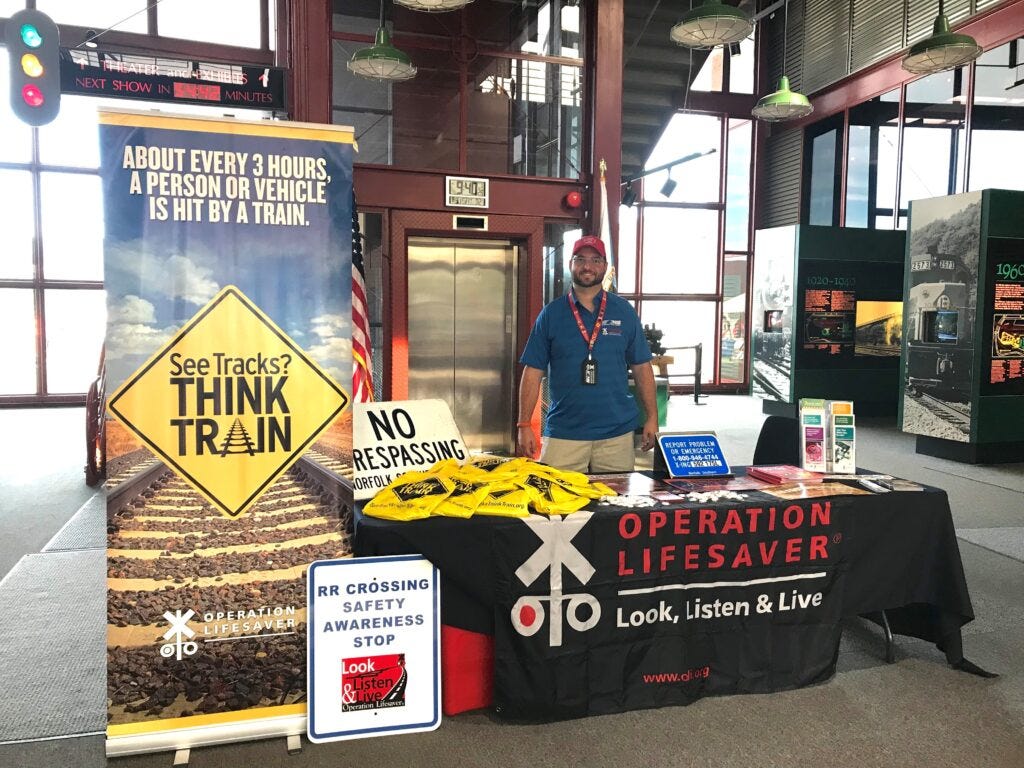
Brock running an informational table for Operation Lifesaver in the Steamtown National Park in 2019.
Now, continuing with his full time career, and with Operation Lifesaver, Brock has rejoined the Conrail Historical Society with the Board of Directors. With the CRHS, Brock hopes to bring light to the various achievements, innovations, and sacrifices of the dedicated employees of Conrail. Brock explained how he feels Conrail is undermined at times, when reality Conrail was the needed savior for railroading in the Northeast after the devastating effects of Hurricane Agnes and the Penn Central merger. He went further to outline how he felt that the hard work of many of the employees had effects that helped resurrect railroading in the Northeast. “Those employees need their stories told,” he explained to me. Brock also will be publishing a book in the near future, titled “Conrail Business and Research Trains: The Special Equipment Fleet”. This book will be a documentation of all of Conrail’s business train equipment, and other oddball geometry train equipment used by the Consolidated Rail Corp.
Living with a lifelong passion for trains, Brock explains that passion as part of the DNA within him to his friends and family. Being a part of the traditions of railroading has opened his eyes to not only a community centered around progress but also persevering the past. He hopes that this community will continue to observe and respect those who came before, and to always be safe around trains.
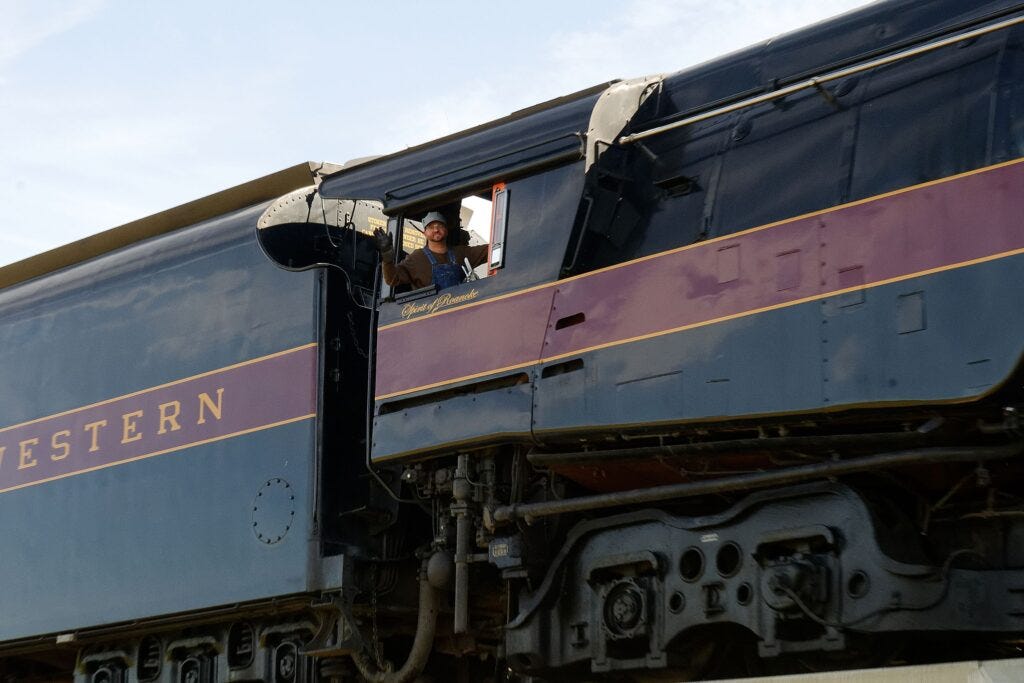
Brock at the controls of the N&W 611 during the throttle time sessions on the Strasburg Rail Road. Photo by Charlie Zimmerman.
Thank you for reading this edition of Behind the Throttle, and thank you to Kris Klemick and Charlie Zimmerman for contributing photos. Tune in next time for another narrative, and until then, I’ll see you down the line.


